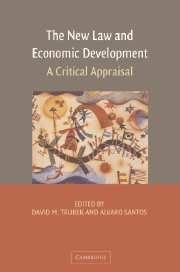Book contents
- Frontmatter
- Contents
- Contributors
- 1 Introduction: The Third Moment in Law and Development Theory and the Emergence of a New Critical Practice
- 2 Three Globalizations of Law and Legal Thought: 1850–2000
- 3 The “Rule of Law” in Development Assistance: Past, Present, and Future
- 4 The “Rule of Law,” Political Choices, and Development Common Sense
- 5 The Dialectics of Law and Development
- 6 The Future of Law and Development: Second-Generation Reforms and the Incorporation of the Social
- 7 The World Bank's Uses of the “Rule of Law” Promise in Economic Development
- Index
3 - The “Rule of Law” in Development Assistance: Past, Present, and Future
Published online by Cambridge University Press: 06 July 2010
- Frontmatter
- Contents
- Contributors
- 1 Introduction: The Third Moment in Law and Development Theory and the Emergence of a New Critical Practice
- 2 Three Globalizations of Law and Legal Thought: 1850–2000
- 3 The “Rule of Law” in Development Assistance: Past, Present, and Future
- 4 The “Rule of Law,” Political Choices, and Development Common Sense
- 5 The Dialectics of Law and Development
- 6 The Future of Law and Development: Second-Generation Reforms and the Incorporation of the Social
- 7 The World Bank's Uses of the “Rule of Law” Promise in Economic Development
- Index
Summary
The issue of the relationship between legal institutions and “development,” whether development is defined narrowly in economic terms, or more broadly, was originally mooted by Max Weber 100 years ago and has continued to fascinate scholars. In recent years, it also has come to interest policymakers as development institutions have placed increasing emphasis on the “rule of law” as a necessary ingredient in any development strategy. The result has been a proliferation of law reform projects and programs supported by development assistance institutions.
In the 1990s, there was a massive surge in development assistance for law reform projects in developing and transition countries. These projects involve investments of many billions of dollars. The World Bank alone reports it has supported 330 “rule of law” projects and spent $2.9 billion dollars on this sector since 1990. At the beginning of this new surge of interest in law within the development community, there appeared to be a broad consensus on the reasons to create the “rule of law” in these transitional and developing economies, on what the “rule of law” meant, and on the best strategies to implement those objectives. But as more was learned about the challenges, and a burgeoning literature emerged, it has become apparent that the initial enthusiasm for the rule of law masked different, and potentially contradictory, visions and approaches.
- Type
- Chapter
- Information
- The New Law and Economic DevelopmentA Critical Appraisal, pp. 74 - 94Publisher: Cambridge University PressPrint publication year: 2006
- 36
- Cited by

